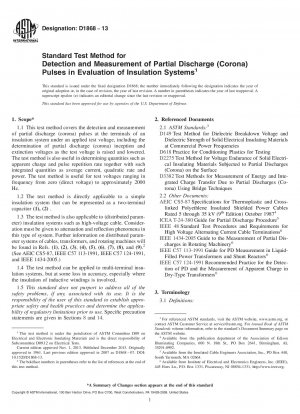ASTM D1868-13
Standard Test Method for Detection and Measurement of Partial Discharge (Corona) Pulses in Evaluation of Insulation Systems
- Standard No.
- ASTM D1868-13
- Release Date
- 2013
- Published By
- American Society for Testing and Materials (ASTM)
- Status
- Replace By
- ASTM D1868-20
- Latest
- ASTM D1868-20
- Scope
5.1 The presence of partial discharges (corona) at operating voltage in an insulation system has the potential to result in a significant reduction in the life of the insulating material. Some materials are more susceptible to such discharge damage than others. This characteristic can be investigated using Test Method D2275.
5.2 The presence of partial discharges (corona) in an apparently solid insulation is a potential indication of the existence of internal cavities. Partial discharge tests have been useful in the design and inspection of molded, laminated, and composite insulation, as well as specimens in the form of cables, capacitors, transformers, bushings, stator bars, and rotating machines (1), (2), (3), (4), (5), (6), (7), (8), (9), (13), and (12). (See also AEIC CS5-87, ICEA T-24-380, IEEE 48, IEEE C57 113-1991, IEEE C57 124-1991, and IEEE 1434-2005.)
5.3 Partial discharge (corona) inception and extinction voltages are used in the determination of the limiting voltage at which an insulation system will operate free of such discharges. The extinction voltage is often substantially lower than the inception voltage. Where the operating voltage is below the inception voltage but above the extinction voltage, it is possible that a transient over-voltage will initiate discharges which then continue until the voltage is lowered below the extinction voltage. Inception and extinction voltages depend upon many factors, including temperature and the rate at which the voltage is changed. After a time at a voltage, it is possible that discharges will start and stop in a nonuniform and unpredictable fashion, especially for discharges within cavities in certain materials, in particular if the discharge degradation products formed are conductive (1), (5).
5.4 The magnitude (pulse height) of a partial discharge is an indication of the amount of energy that it dissipates in the insulation system. Partial discharge magnitude and pulse rate are useful in estimating the rate, or change of rate, at which deterioration is produced.
5.5 In general, the occurrence of partial discharges is not directly related to the basic properties of a solid insulating material, but usually results from overstressing of gaseous occlusions or similar imperfections or discontinuities in an insulating system. It is possible that partial discharges will originate at locations such as on the leads or terminals without resulting in any hazard within the main part of the insulation system.
......1.1 This test method covers the detection and measurement of partial discharge (corona) pulses at the terminals of an insulation system under an applied test voltage, including the determination of partial discharge (corona) inception and extinction voltages as the test voltage is raised and lowered. The test method is also useful in determining quantities such as apparent charge and pulse repetition rate together with such integrated quantities as average current, quadratic rate and power. The test method is useful for test voltages ranging in frequency from zero (direct voltage) to approximately 2000 Hz.
ASTM D1868-13 Referenced Document
- ASTM D149 Standard Test Method for Dielectric Breakdown Voltage and Dielectric Strength of Solid Electrical Insulating Materials at Commercial Power Frequencies
- ASTM D2275 Standard Test Method for Voltage Endurance of Solid Electrical Insulating Materials Subjected to Partial Discharges (Corona) on the Surface
- ASTM D3382 Standard Test Methods for Measurement of Energy and Integrated Charge Transfer Due to Partial Discharges (Corona) Using Bridge Techniques
- ASTM D618 Standard Practice for Conditioning Plastics for Testing
- IEEE 48 IEEE Standard for Test Procedures and Requirements for Alternating-Current Cable Terminations Used on Shielded Cables Having Laminated Insulation Rated 2.5 kV through 765 kV or Extruded Insulation Rated 2.5 kV through 500 kV
ASTM D1868-13 history
- 2020 ASTM D1868-20 Standard Test Method for Detection and Measurement of Partial Discharge (Corona) Pulses in Evaluation of Insulation Systems
- 2013 ASTM D1868-13 Standard Test Method for Detection and Measurement of Partial Discharge (Corona) Pulses in Evaluation of Insulation Systems
- 2007 ASTM D1868-07 Standard Test Method for Detection and Measurement of Partial Discharge (Corona) Pulses in Evaluation of Insulation Systems
- 1993 ASTM D1868-93(1998) Standard Test Method for Detection and Measurement of Partial Discharge (Corona) Pulses in Evaluation of Insulation Systems
